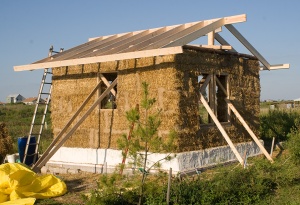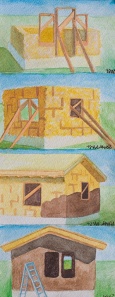 A year after building the cob house our daughter Anna started an even smaller house on our land. Her 14×14′ house was built in the fall of 2007 using a technique that we had learned from Ianto Evans, our cob mentor. Bale/cob is a structural strawbale system where corner bales are pinned together with internal stakes and reinforced with cob pushed into all the joints between bales. The whole wall is then covered with a 3″ layer of cob inside and out. This technique gives more protection to the bales than standard strawbale and has much more insulation than standard cob. It could work even though ours didn’t.
A year after building the cob house our daughter Anna started an even smaller house on our land. Her 14×14′ house was built in the fall of 2007 using a technique that we had learned from Ianto Evans, our cob mentor. Bale/cob is a structural strawbale system where corner bales are pinned together with internal stakes and reinforced with cob pushed into all the joints between bales. The whole wall is then covered with a 3″ layer of cob inside and out. This technique gives more protection to the bales than standard strawbale and has much more insulation than standard cob. It could work even though ours didn’t.
Here is Anna placing the first course of bales on rigid foam over the concrete grade beam.
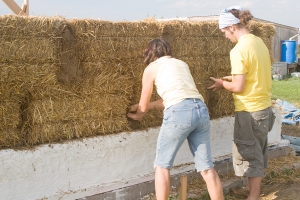 Lin and Chris push the cob into the joints.
Lin and Chris push the cob into the joints.
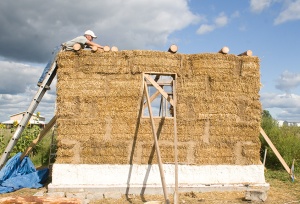 I am positioning pine logs on the finished wall. These will be cobbed in place to give us something to attach rafters to.
I am positioning pine logs on the finished wall. These will be cobbed in place to give us something to attach rafters to.
 Anna and a volunteer plant the living roof.
Anna and a volunteer plant the living roof.
 And now the rest of the story.
And now the rest of the story.
Anna moved into the house in November and started using the rocket stove daily. The cob floor, inside walls and stove were dry enough to be hard but still giving water vapor to the air. With windows closed that vapor had nowhere to go but into the bale/cob walls. In a breathing wall this would not have been a problem. The vapor would go out into the environment.
You will note the plaster on the outside of Anna’s house. This is a cement based stucco called Litewall which was has a tested perm rating of 42. Of course, it wasn’t tested on bale/cob. Over the winter we noticed plaster bubbling and falling off. In the early spring I moisture tested the bales. Many pegged the meter. The lowest reading was 25% which is double the acceptable moisture content for a strawbale wall.
 There was nothing we could do but remove the rotting bales. After building a temporary support for the roof we pulled down the outside layer of cob and the bales. Fortunately, most of the inside layer of cob stayed put. I built a stud wall to support the roof and we stuffed the wall cavity with light straw/clay which is straw that has been tossed in clay slip like oiling a salad. Once the wall was stuffed with this clay covered straw we wrapped the outside with jute fabric and plastered it with our clay/cow dung exterior plaster.
There was nothing we could do but remove the rotting bales. After building a temporary support for the roof we pulled down the outside layer of cob and the bales. Fortunately, most of the inside layer of cob stayed put. I built a stud wall to support the roof and we stuffed the wall cavity with light straw/clay which is straw that has been tossed in clay slip like oiling a salad. Once the wall was stuffed with this clay covered straw we wrapped the outside with jute fabric and plastered it with our clay/cow dung exterior plaster. 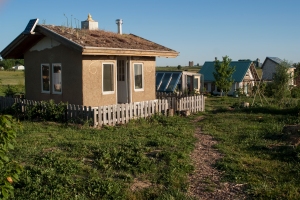 And so Anna’s little house lives on.
And so Anna’s little house lives on.


